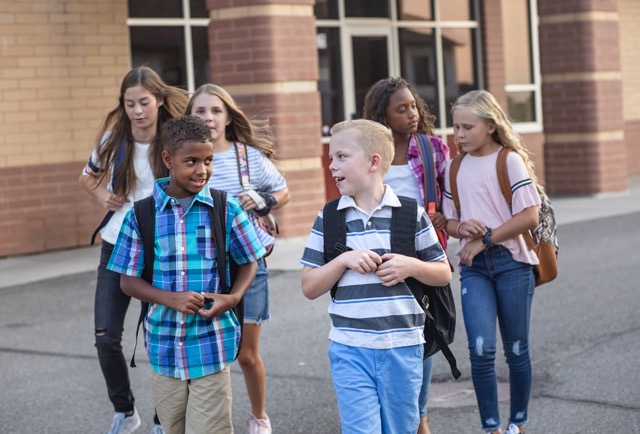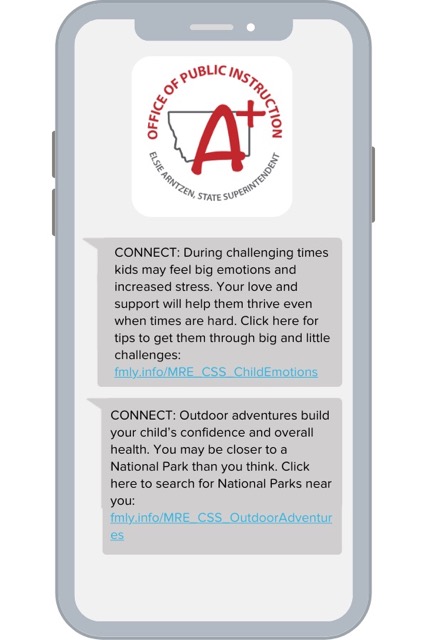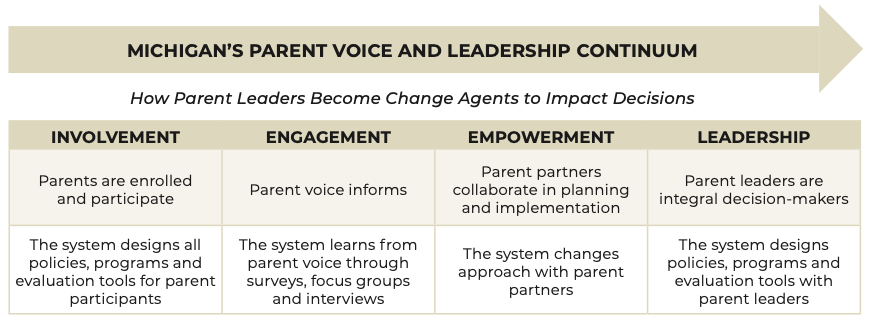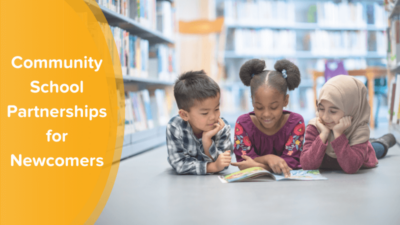By Maren Madalyn, contributing writer
If I were to ask every educator in the U.S. if they have ever worked with a newcomer student, I suspect that nearly all would respond with “YES.” Though some states may serve more refugee or immigrant families than others, there can be no doubt that there are many families and children in our education system who are, or once were, brand-new to the U.S.
In fact, in 2022, over 46.2 million immigrants lived in the United States — the most ever in our country’s recent history.
For educators, there is so much that we can learn from families arriving from other countries and making a new home within our own. At the same time, we must recognize the necessary needs of these members of our school communities. And one of the most effective ways to support them is through caregiver and parent engagement.
Let’s take a closer look at what strategies are effective to drive parental involvement newcomer families both appreciate and need!
Newcomer families: Who they are, what they navigate, and why supporting them is essential
Newcomer families are especially important in a school community. They may be recent migrants from another country, seeking new opportunities for themselves and their children. They may be refugees fleeing violence in their countries of origin.
Regardless of where they come from, newcomers bring cultural perspective, knowledge, history, traditions, linguistic diversity, and much more to a school. These assets benefit their children and are powerful when woven into student learning opportunities.
And — it is no secret that newcomer families face often daunting challenges as they transition to a new country, new culture, and usually a new language. Below are just a few of the most common barriers that refugee or immigrant parents must navigate:
Language
Learning any new language can be a major feat to accomplish. Oftentimes for newcomers, many must quickly learn English in order to adapt to life in the U.S. and secure employment and stable housing. Newcomer families benefit from supports that boost their English skills as part of this transition.
Access to basic needs
In some cases, newcomer families arrive in our country with very few resources and connections for support. National and local organizations may tailor their services specifically to help migrant and refugee families successfully access food, shelter, and other basic necessities that every human needs to thrive. These partnerships with families are essential to give newcomers a healthy start in their new lives.
Cultural expectations around education
Every country’s school system looks a little different from their neighbors. In some cases, educational norms common to the U.S. may be outlandish or unheard of in other countries! It behooves educators to aid newcomer families as they learn new customs (as well as legal expectations) around things like attendance at school, co-ed classrooms, etc.

Trauma
Many newcomer families and students arriving to U.S. schools carry adverse childhood experiences or even more recent traumas with them. Educators and community organizations supporting migrant and refugee families may lean on practices informed by the protective factors framework, designed to help minimize the risk of re-traumatization with kids and adults alike.
Programs like ParentPowered Trauma-Informed are great examples of how family support can aid newcomers. This curriculum is specifically designed to help mitigate the negative effects of trauma, which impact everything from student academic achievement to future adult wellbeing.
Why family engagement matters for newcomers
Many educators are already aware of the immense benefits that effective family engagement in schools brings to children, parents, and schools alike. But research also shows that, time and time again, a thoughtful approach to family engagement also supports families new to the U.S.
A study with elementary schools explored the nature of family-school relationships and how it affected relational power among families of black African migrant children — basically, how individuals in a community influence one another’s behavior. As the author explains, when educators and families trust each other and positively influence each other through collaboration, immigrant parents and school staff better navigate racial inequalities and discrimination, boost student academic achievement, and improve social-emotional outcomes for children. (Dryden-Peterson, 2017).
Another study found that schools can support migrant children with adapting to a new country. The authors found that a healthy school environment can become a space for delivering crucial services (such as healthcare or parent education), improving social-emotional learning, building resilience against trauma, and more (Patel et al., 2023).

The verdict on family engagement for refugees, migrants, and other newcomers is clear — when done well, it can make all the difference for caregivers and children alike!
How can educators then adapt family engagement to meet these families’ unique needs while also honoring the valuable contributions of newcomers?
4 tips to cultivate the kind of parental involvement newcomers and schools need
Focus on basic knowledge of schooling in the U.S.
For many newcomer families, the U.S. school system is challenging to learn from the ground up. Schooling may have looked quite different in their countries of origin, too. With this in mind, you can encourage parental involvement among newcomer families by first going back to basics and providing everyone with essential knowledge about how your schools operate.
Newcomers aren’t the only ones who benefit from getting detailed information about processes like registering for school, signing up for school lunches, riding the school bus, and more!
When educators challenge common assumptions about what families already know, they set up all families for greater success by aligning them on expectations for their child’s education and ways to support it. Here are a few strategies to help you get started with scaffolding the U.S. school experience with all of your families:
- Examine your communications for accessibility. It is helpful to read everything from teacher emails to school newsletters with this guiding question: Will a family brand-new to our school and our country understand what’s expected of them? Be sure to identify any education jargon or other common terminology in your communications, too. References to concepts such as “minimum days” may not be inherently clear to all families — so see if you can add context or definitions to ensure everyone understands that, on minimum days, school ends early.
- Design a family handbook specifically for newcomers. Many educators are finding value in compiling key information and resources for families into a single place (available in families’ native language, of course). Better still, some are taking these handbooks to the next level, specifically adding in greater detail or insight into core school processes as well as contact information for local organizations that can support newcomers with their transition to the U.S. Download our guide Welcome To School In The U.S. as a starting point for crafting your own newcomer handbook.
Want more suggestions for scaffolding the fundamentals of schooling for newcomers? Watch our on-demand webinar to hear how America Lopez, Community Health Worker for Volunteers in Medicine, took her personal experiences as a newcomer to develop tailored supports for other newcomer families in her school district.
Design all engagement with cultural responsiveness in mind
If you’re familiar with ParentPowered, then you probably already know how much we value cultural responsiveness in family-school partnerships.
Culturally responsive family engagement is powerful for newcomer families, who arrive at schools with different cultural and personal backgrounds. But it’s really helpful for all caregivers and students. This approach is all about designing a welcoming learning environment that celebrates diversity in language, history, ethnic backgrounds, and much more.
Newcomers benefit from seeing their stories and experiences reflected in learning spaces — from the classroom curriculum to images posted around school and beyond. Such environments create trust and a sense of belonging, both of which must come first for educators to build positive relationships with their families.
Explore these tips for designing culturally responsive family engagement programs in your school community:
- Start with self-reflection. Recognizing personal experiences and knowledge (as well as gaps in both) is the first step to connecting with families across cultural differences. By increasing your self-awareness and reflection skills, you may be better able to receive new and potentially challenging insights from others in your community. Read one principal’s reflections on the power of cultural competency for both teachers and administrators.
- Give families learning activities that uplift cultural knowledge. Every family brings funds of knowledge to their students’ learning journeys. When educators offer learning activities that anyone from any cultural or linguistic background can do — such as ParentPowered’s activities — multilingual families can share their knowledge while also directly impacting student achievement. Storytelling is a fantastic way to do this because it helps build early reading skills and can be done in any language!
Get creative with additional supports for newcomers
Most of your families will benefit from the “fundamental” engagement opportunities that schools provide, such as parenting workshops and family handbooks. However, some families just need extra help to build their capacity to support children’s learning. Newcomers are often among these families.
Here are a few examples of extra supports that greatly help newcomers:
- English Language development opportunities for parents and caregivers
- Assistance with accessing basic needs, such as food and housing
- Support with employment opportunities, including interview practice, resume writing, and job search skills
This list barely scratches the surface of what’s possible. What matters most is for you to take time to understand what your families need to succeed, including and beyond newcomers. Educators can help connect families with community resources, whether it’s through direct community school partnerships, providing contact information to specific organizations, or simply normalizing families’ needs.
Use these ideas to begin cultivating a network of targeted supports for newcomers and more families:
- Ask families what they most need to thrive. Sometimes topics like mental health and housing instability can feel extremely vulnerable for families to discuss. Anonymous family surveys or conversations with key community leaders that hold families’ trusts can help your team identify those needs. For newcomers, consider partnering with those organizations that directly serve such families for more insights.
- Re-examine your existing family engagement strategies. Oftentimes, it’s easier and more effective to adjust family engagement approaches rather than start from scratch. Take parent-teacher conferences, for instance. What tweaks can your school staff make to set up multilingual or newcomer families for greater engagement during these meetings? If your schools host on-site events like Open House and Back To School Night, consider inviting local organizations to host a booth for families.

With all these strategies, it helps to brainstorm how your team can share information or resources with families who cannot join in-person or may face barriers to participating in such events. Technologies like ParentPowered’s Community Support Stream, a key component of the Trauma-Informed program, are excellent for helping school and district leaders get resources into families’ hands.
Build a network of trusted leaders — then LISTEN to them!
Dr. Karen Mapp, creator of the Dual Capacity-Building Framework (DCBF), emphasizes that all engagement work is meant to build mutual trust and respect between families and educators. With newcomers, trust is the most important part of successful collaboration that centers student learning.
More often than not, there are newcomer parents or caregivers whom the community already respects and trusts. When you partner with these family leaders, you can help build bridges between school and home. In fact, many family engagement frameworks (such as the DCBF and ECIC Michigan’s Parent Voice and Leadership Continuum) highlight structures that help schools and families co-create great learning experiences together.
Creating family leadership opportunities also helps you and your team understand how to better collaborate with families to improve school climate, better tailor student learning supports, and so much more.

Read ECIC Michigan’s report exploring the evolution of parent leadership for more insights, inspirations, and recommendations for cultivating these opportunities in your own community.
Deepen newcomer family partnerships with ParentPowered
Ready to deepen partnership, parental involvement, and community engagement with newcomer families? ParentPowered has your back. Our Trauma-Informed family engagement curriculum scaffolds families’ experiences with schools and ways to directly support their children’s learning, from birth through high school.
Through our Trauma-Informed program, we’ve partnered with educators like you to:
- Streamline access to parenting tips, learning activities, and local community resources among rural families
- Preserve essential cultural knowledge by offering practical resources and learning ideas through text-based family engagement
- Uplift migrant families and students by providing consistent, research-backed educational supports in families’ home languages
Join an upcoming info session or take a self-paced tour of the program to learn more.
About the author
Maren Madalyn has worked at the intersection of K12 education and technology for over a decade, serving in roles ranging from counseling to customer success to product management. She blends this expertise with fluid writing and strategic problem-solving to help education organizations create thoughtful long-form content that empowers educators.









